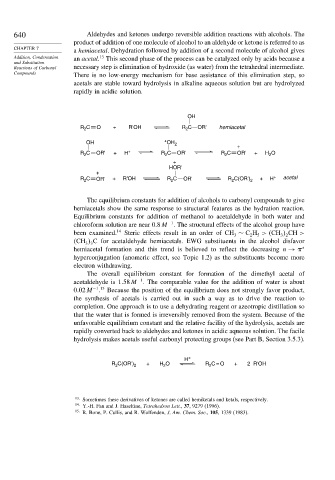Page 658 - Advanced Organic Chemistry Part A - Structure and Mechanisms, 5th ed (2007) - Carey _ Sundberg
P. 658
640 Aldehydes and ketones undergo reversible addition reactions with alcohols. The
product of addition of one molecule of alcohol to an aldehyde or ketone is referred to as
CHAPTER 7
a hemiacetal. Dehydration followed by addition of a second molecule of alcohol gives
Addition, Condensation an acetal. This second phase of the process can be catalyzed only by acids because a
13
and Substitution
Reactions of Carbonyl necessary step is elimination of hydroxide (as water) from the tetrahedral intermediate.
Compounds
There is no low-energy mechanism for base assistance of this elimination step, so
acetals are stable toward hydrolysis in alkaline aqueous solution but are hydrolyzed
rapidly in acidic solution.
OH
R C O + R'OH R C OR' hemiacetal
2
2
OH + OH 2
+
R C OR' + H + R C OR' R C OR' + H O
2
2
2
2
+
HOR'
+
R C OR' + R'OH R C OR' R C(OR') 2 + H + acetal
2
2
2
The equilibrium constants for addition of alcohols to carbonyl compounds to give
hemiacetals show the same response to structural features as the hydration reaction.
Equilibrium constants for addition of methanol to acetaldehyde in both water and
−1
chloroform solution are near 0 8M . The structural effects of the alcohol group have
been examined. 14 Steric effects result in an order of CH ∼ C H > CH CH >
3 2 5 3 2
CH C for acetaldehyde hemiacetals. EWG substituents in the alcohol disfavor
3 3
hemiacetal formation and this trend is believed to reflect the decreasing n → ∗
hyperconjugation (anomeric effect, see Topic 1.2) as the substituents become more
electron withdrawing.
The overall equilibrium constant for formation of the dimethyl acetal of
−1
acetaldehyde is 1 58M . The comparable value for the addition of water is about
−1 15
0 02M . Because the position of the equilibrium does not strongly favor product,
the synthesis of acetals is carried out in such a way as to drive the reaction to
completion. One approach is to use a dehydrating reagent or azeotropic distillation so
that the water that is formed is irreversibly removed from the system. Because of the
unfavorable equilibrium constant and the relative facility of the hydrolysis, acetals are
rapidly converted back to aldehydes and ketones in acidic aqueous solution. The facile
hydrolysis makes acetals useful carbonyl protecting groups (see Part B, Section 3.5.3).
H +
R C(OR') 2 + H O R C = O + 2 R'OH
2
2
2
13 Sometimes these derivatives of ketones are called hemiketals and ketals, respectively.
14 Y.-H. Fan and J. Haseltine, Tetrahedron Lett., 37, 9279 (1996).
15
R. Bone, P. Cullis, and R. Wolfenden, J. Am. Chem. Soc., 105, 1339 (1983).

